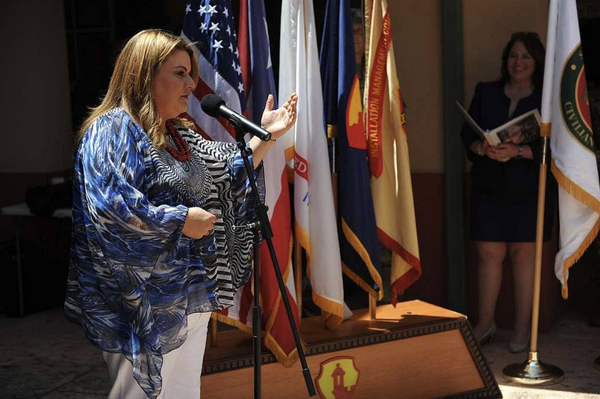BALTIMORE — The oak, beech and tulip poplar trees of School House Woods stand a mighty 10 stories tall, their branches interlaced in a canopy so high you must crane your neck to see them. Fallen trunks crisscross the ground far below, their roots dangling into the leaves that carpet the forest floor. In this enclave some say is 10,000 years old, tiny sprigs emerge from decaying bark.
The 14-acre swath within the Wye Island Natural Resources Management Area in Queen Anne’s County, is one of nature’s rarest commodities: an old-growth forest — a woodland that has never been altered by humans.
Such forests have unique value, says Joan Maloof, a botanist, author and environmental activist from Berlin in Worcester County, as she gives a visitor a walking tour. They serve as filters for air and water, function as storehouses of genetic information, and represent living remnants of eons gone by.
The problem is, humans have driven them to the verge of extinction. Of the old-growth forest that once covered the Eastern portions of North America, Maloof says, more than 99% has either been removed or radically altered, while about 96% has been decimated in the western portion of the continent. In Maryland, 2,300 of the state’s 2.8 million acres of forested land — less than a tenth of 1% — have been inventoried as old growth. And much of what been untouched, including School House Woods, has no legal protection against logging.
If anyone has successfully pushed back against such depletion, it’s Maloof. Her five books helped bring the crisis into the public eye. Her nonprofit Old-Growth Forest Network is going strong nationwide in its 10th year. And she succeeded last month in getting a bill introduced in the Maryland General Assembly that would ban the logging of old-growth forest on all state conservation land.
Its chief sponsor, Democratic Del. Jim Gilchrist of Montgomery County, says the bill’s prospects are not clear. But Maloof, 65, says she wouldn’t have made it this far without remaining as resilient as the forests she champions.
“I’m an optimist,” she says. “Who could vote to support cutting down old-growth forests? I think it has a very good chance.”
Determined activist
Virgin forests contain so many varying elements and are often so hard to distinguish and locate that “you could spend a few years just defining ‘old growth,’” says Tom Horton, an environmentalist, author and former Baltimore Sun reporter who has written extensively about them.
Naturalists generally agree that an old-growth forest has lived at least 150 years free of significant human intervention. They also say the subject is so broad and variable that it takes an unusually determined activist to make inroads in preserving them.
Maloof fits that description. Growing up in Delaware, her father was a chemical engineer who helped lead production of the pesticide DDT and had little sympathy for environmental causes. That didn’t stop her from falling in love with plants, debating ecological questions with her father, and majoring in plant sciences at the University of Delaware.
She studied local flora in college, worked in horticultural design and joined the faculty at Salisbury University, where she helped lead the creation of an environmental sciences department and made a lasting impression.
Horton, an adjunct professor in the program, says a university administrator once told the faculty of a plan to cut down a tree to make room for a building. Maloof threatened to chain herself to the trunk and force him to “cut her away first.”
“She’s a rather delicate-looking lady, but I wouldn’t want to go up against her,” Horton says. “He changed his mind.”
As a doctoral student at the University of Maryland, Maloof traveled to Colorado to study plant-pollinator interactions in “beautiful wildflower fields that are completely natural.” With that, she discovered her core interest — an area of study she calls “ecology minus humans.”
Back at Salisbury, she reasoned, what better places for investigating that idea than in ancient virgin forests? That was when she became aware there were fewer than 20 acres’ worth on Maryland’s entire Eastern Shore, and the closest — School House Woods near Queenstown — was 70 miles away.
Alarmed at the scarcity, Maloof set out to research and write her first book, a call to arms titled “Teaching the Trees,” in 2005. So many readers wrote to ask where they could find an old-growth forest that she followed up with a second book, “Among the Ancients,” in 2011. For that one, she visited and wrote about one such forest in each of the 26 states east of the Mississippi.
By then, Maloof says, she was starting to feel like a forest seeking its best nutrients and leaving the rest behind. At 54, she left a tenured professorship and started anew.
“I realized I could do more to help the trees as a writer than as a science teacher,” she says.
Going national
Drive to the Dans Mountain Wildlife Area in Allegany County and, using a map on the Old-Growth Forest Network website, you may find a Table Mountain pine that dates to 1678. It’s the oldest specimen in a 180-acre old-growth forest. Or head into Garrett County to experience a rare 37-acre grove of hemlock in Swallow Falls State Park.
Most of the other known old-growth sites on public land in Maryland also represent substantial drives from Baltimore: All but four of the 40 locations the Maryland Department of Natural Resources identified on 2,300 acres during a 2007 survey are in Western Maryland. Maloof’s network includes old-growth or near-old growth spreads in Southern Maryland and on the lower Eastern Shore.
Closer to Baltimore, the 625-acre Belt Woods Natural Environment Area near Largo is largely old growth. Baltimore City has at least two sites that probably qualify: Maloof says she believes Gwynns Falls/Leakin Park fits the definition, and the city Department of Recreation and Parks says Druid Hill Park contains some of the state’s oldest forest growth.
Bob Leverett, a Massachusetts-based naturalist considered a pioneer in the study of old-growth forests, has been trying to save such sites in his part of the country since the early 1980s. He’s the executive director of the Native Tree Society, which documents trees worldwide.
Leverett talks about how the accumulated biomass of old-growth forests serves as “huge carbon sinks.” Logging and planting new forests “moves our clock back” so far it will take at least 150 years to begin to replace their value. Meanwhile, climate change makes it “extremely important to retain as much forest cover as we can.”
A relative handful of scientists have studied the problem for decades, Leverett says. But until Maloof came along, they were either academicians writing theses or activists focused on saving individual forests. Maloof’s books explained the crisis in clear, even poetic, language, he said, communicating the problem to a broader audience.
Her next endeavor made it a national movement. One reason she retired 11 years ago, Maloof says, was to identify and support nonprofit groups addressing the imperilment of old-growth forests on a national scale. There weren’t any, so she started one.
Her idea was to identify at least one old-growth or near old-growth forest in every county in the nation in which forests can grow, ensure that they have public access and are legally safeguarded against logging, and build “a network of people inspired to protect them.”
Maloof worked for a year to set up a board, network and locate potential donors, all without pay. Soon she’d found enough supporters that she needed a volunteer treasurer, then a paid assistant. Little by little, it grew.
Ten years later, the Old-Growth Forest Network includes at least one confirmed ancient forest in each of 148 counties in 28 states, including California, Oregon, Michigan, Florida, both Carolinas and New York. More than 300 county coordinators help promote those locations and look for others, six regional managers help develop policy, and there are more than 4,000 people on the mailing list.
The network had a budget of more than $600,000 in 2021, funded almost entirely by charitable contributions. Its revenues support operations, as well as Maloof’s travels to forest sites and the roughly two dozen lectures she gives per year.
There’s a long way to go, of course. More than 2,300 of the nation’s 3,140 counties, or about 75%, boast the right conditions to host a forest. But Leverett says Maloof qualifies as a pioneer.
“Her network really kind of exploded, and it’s still growing,” he says. “She has met with as much success as anyone could have imagined in this field.”
Seeking protection
Of the hundreds of forests she has visited across the country, Maloof points to School House Woods as a favorite. Its diversity is unrivaled in the state, she says, as trees rarely seen in the same place — oak, beech, cherry, sassafras, hollies and dogwoods — exist side by side. It’s also accessible to the public, with walking trails leading through a site with “some of the most healthful air in Maryland.”
No one knows how it got its name or why it escaped clear-cutting. The absence of evidence of any logging activity means it has probably functioned as an ecosystem since the glaciers receded from North America some 10 millennia ago.
“Irreplaceable,” says Maloof, one hand resting against the rough bark of a giant red oak.
Visitors routinely suggest she add School House Woods to the network. But the complicated patchwork of laws governing the protection of old-growth forests leaves the site, like many others in Maryland, unprotected against logging.
Those laws can be as difficult to disentangle as the ecosystems themselves. Hard-and-fast regulations at the federal level are few, and 42 states, including Maryland, lack statewide laws on the matter.
In Maryland, the Department of Natural Resources owns and manages over 500,000 acres of public lands and protected open space. The logging of old-growth forests is effectively prohibited in the roughly 230,000 acres Maryland classifies as state forest; the state prevents logging there to comply with the standards of the international Forest Stewardship Council. It’s also barred in the nearly 66,000 acres the General Assembly defines as wildland — terrain that overlays some of state forests.
But a parcel must generally contain 500 or more acres to be considered for wildland status. Most known old-growth sites, including School House Woods, are too small to qualify.
Maloof knows of no logging interests eyeing “our poster forest,” as she calls School House Woods, but she notes that such cutting already has happened in other states.
“Why wait until it becomes an issue?” she says. “It would cost almost nothing to guarantee its safety.”
She and a few friends have met regularly for years to map out possible strategies. Last month, one of the group, retired Midshore Riverkeeper Conservancy director Jeff Horstman, crafted the state bill that would ban logging on state land of any forests the Department of Natural Resources or the Maryland Environmental Trust defines as old growth.
Gilchrist and fellow Democratic delegates Linda Foley of Montgomery County and Brooke Lierman of Baltimore signed on, and witnesses spoke Feb. 25 in support of the legislation at a hearing.
Should it fail this year, Maloof says, she won’t be discouraged. The mission will face setbacks, but she believes it will adjust to meet new conditions, becoming stronger and more resilient with time.
“I love that things seem to be working out this way,” she says. “It feels like a forest growing.”
———







